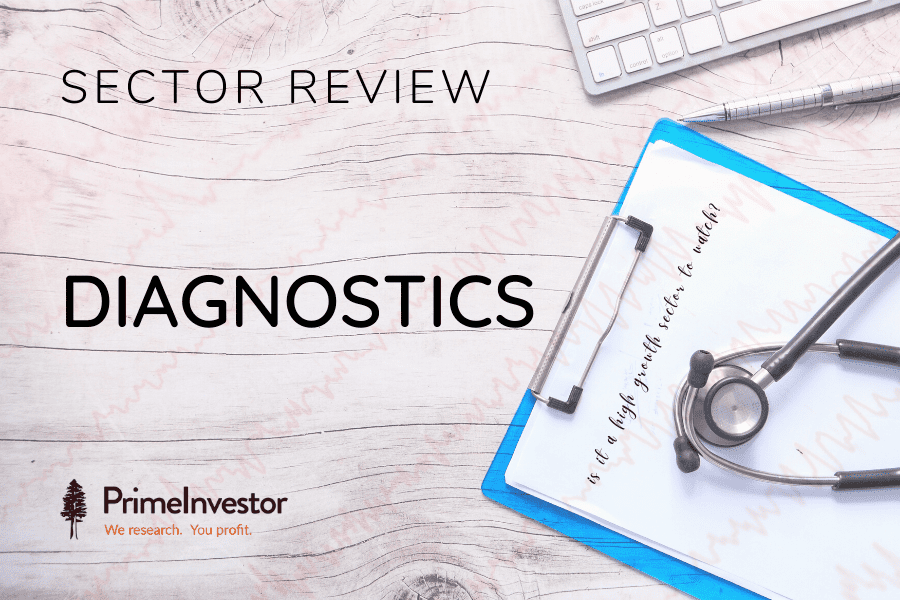There is nothing quite like a pandemic to put the healthcare sector firmly in the spotlight. But even without a pandemic, the healthcare sector has been growing. A Niti Aayog report on ‘Investment Opportunities in India’s Healthcare sector’, points out that the sector has grown 22% annually since 2016 and is a key sector in terms of both revenue and employment generation.
Within this broad sector, the diagnostic and pathology segments have come in for a lot of attention. The Niti Aayog report above highlights the potential strong growth in these sub-sectors. Stock markets haven’t been far behind in recognizing growth potential, having churned out a few multi-baggers in the last 3 years. Here is a look at the diagnostics sector space, the key players, how they have weathered the Covid storm and, more importantly, where it could be headed.
So far, we have done individual stock reviews of companies that are interesting, or have seen price rallies, or undergoing a transformation and so on. We’re now expanding these reviews to cover a sector’s prospects and bring a deeper explanation for a sector’s structure, growth, or challenges. These reports will help you gain a better understanding of a sector and also familiarize you with key stocks in that sector. These sector reviews are intended to give you an understanding, and are NOT our recommendations.

The industry
The diagnostics business comprises of two parts:
- Pathology (samples collected and tested in a lab) – less capital intensive and more widely offered
- Radiology / imaging – more capital intensive and less widely available compared to pathology.
While there is no formal industry size, estimates place it at around Rs. 700 billion. The annual report of one of the forerunners in this space, Dr Lal PathLabs, places the industry size at over Rs. 675 billion with a CAGR of over 10% for the next 10 years. The IPO documents of Krsnaa Diagnostics that listed earlier in August, corroborate the size and place growth estimates higher at 15%. A quick look at the aggregate turnover for three of the listed pure diagnostics sector players only reinforces the growth rates with a CAGR of over 14% for the last 3 years.
So, what can drive growth in the industry? Diagnostic testing is gaining increasing importance as the basis for an increasing percentage of treatments. As explained above, estimates place growth at 10%-15%. The following factors support this growth potential.
- A steadily rising life expectancy would add to demand as a section of the population advances in age.
- Greater prevalence of lifestyle diseases combined with increased awareness and a focus on prevention could fuel demand. Though the bulk of India’s population is younger than 40, going by data in the UN Demographic Yearbook 2020, 14% of the population currently in the 30-39 age bracket will start to move into the ‘over 40’ category. This age is the ballpark for when screening for most lifestyle diseases picks up. Diagnostic chains are banking on the business potential of preventive awareness too, through packaged diagnostic products such as ‘Swasthfit’ from Dr Lal Path Labs and the tests under the ‘Aarogyam’ umbrella of Thyrocare Technologies.
- Increasing per capita income in the last 20 years and a rise in insurance coverage
- Initiatives such Ayushman Bharat Pradhan Mantri Jan Arogya Yojana, that aim to make healthcare more accessible can improve spending on healthcare.
Key Players
The diagnostics sector is highly fragmented. Players in this space are typically one of three types:
- Standalone players, which account for about half the market
- Hospitals that run their own labs and
- National or regional chains, which is where the listed players such as Dr Lal PathLabs, Metropolis Healthcare or Vijaya Diagnostic Center are. These organized diagnostic chains account for less than 20% of the market. They are able to drive economies of scale by operating on a scalable, asset-light hub and spoke model.
The key listed players are Dr Lal PathLabs, Metropolis Healthcare and Thyrocare Technologies, each with a few distinct areas of strength.
- Dr Lal PathLabs is a leader with strong brand loyalty in the north with 37% of its revenue flowing from Delhi and NCR and another 29% from the rest of North India. You can take a look at our detailed stock review of Dr Lal PathLabs here. Providing an extensive menu of tests, it is also known for its efficient cash generation, and has been able to successfully fuel its inorganic expansions.
- Metropolis Healthcare, on the other hand, has a strong presence in the west, from where it derives over 50% of its revenue, followed by the South that accounts for another 25% (Q2FY22). While it offers a range of tests, there is a focus on specialized tests (43% of non-covid revenue in Q2FY22) where price-based competition is less intense. Metropolis is also working on deriving 65% of its sales from the higher margin B2C segment in its focus cities.
- Thyrocare Technologies focusses on providing cost-effective pathology testing, especially in the wellness and preventive testing segment and the often-overlooked TB diagnosing space. The business is primarily B2B driven with its army of authorized service providers feeding its processing labs with samples sourced from local hospitals, nursing homes, labs and diagnostic centers. Recently, Thyrocare has been in the news as it is getting acquired by API Holdings, the parent of PharmEasy, a leading healthcare aggregator.
Apart from the three above, the diagnostics sector has recently seen two additions in the listed space:
- Krsnaa Diagnostics, that derives over 60% of its revenue from PPP contracts (Karnataka, Maharashtra and Rajasthan account for 70% of its revenue). It sets up and runs diagnostic centers for public health agencies for tenures which are usually 2 to 10 years with an extension of another 2 to 5 years. This provides revenue visibility for that duration. The flipside however is that prices are determined by the contracts and are usually lower than market rates (by almost 50%) even though they come with an inbuilt escalation clause. This makes their business largely volume-dependent.
- Vijaya Diagnostic Center which is a more regional player (primarily Hyderabad and rest of Telangana and Andhra Pradesh) with its sights set on spreading to the East.
Other diagnostic chains are typically those nested under large hospitals. Fortis-owned SRL Diagnostics is an example. Earlier this year, SRL acquired its JV partner in Kerala, DDRC, effectively stamping its mark in the south. It targets increasing the share of the higher-margin B2C (54% of total revenue in Q2FY22) business in the revenue mix. Another example is Apollo Diagnostics, run by Apollo Health & Lifestyle, a wholly owned subsidiary of Apollo Hospitals Enterprise.
Other players jumping on the bandwagon and starting to set up diagnostics chains include Kochi-based Aster DM Healthcare, Max Healthcare’s subsidiary ‘Max Lab’ and pharma major Lupin’s ‘Lupin Diagnostics’.
While these (hospital owned chains and new arrivals) are subsidiaries of larger healthcare players, the possibility of some being hived off to unlock value at some point in the future cannot be ruled out.
Rising to the pandemic challenge
While the longer-term outlook holds good, the sector, like others, took a hit from the pandemic-induced lockdown.
- Fall in footfalls: On the business front, they had to contend with a drop in footfalls due to restrictions and hesitancy on the part of the patients to visit healthcare establishments for anything non-essential. For example, Dr Lal PathLabs saw patient volumes fall to 3.5 million in the June 20 quarter against 4.9 million in the year-ago quarter. Metropolis Healthcare’s patient numbers fell to 1.37 million in the same period.
- Revenue and margin pressure: Naturally, the lower patient numbers led to a sharp fall in revenue. Aggregate revenue for the three players dropped 24% in the June 20 quarter over the preceding March 20 quarter and 28% against the June 19 quarter. Margins too took a hit with the aggregate EBITDA margin dropping from 32% in the June 19 quarter to 18% in the June 20 quarter.
- Further, ensuring timely availability of raw materials (such as reagents) and movement of samples amidst logistical limitations proved to be tricky.
However, the hit to revenues and margins were short-lived and limited to the June 20 quarter thanks both to a pick-up in patient numbers and companies’ own initiatives. By the September 20 quarter, footfalls began to pick up with Dr. Lal PathLabs touching 5.4 million and Metropolis Healthcare touching 2.62 million patients in the quarter. This apart, other factors helped cushion toplines and eased margin pressure.
- One, Covid-19 testing gave a boost to revenues, especially at the outset before price controls were introduced.
- Two, companies stepped up their game in areas such as online accessibility and home collections to compensate for the lower footfalls. Dr Lal PathLabs, for instance, undertook targeted initiatives to strengthen the digital experience and home collection services. This meant that they were more prepared when the second wave hit, as well. Similarly, Metropolis undertook several digital initiatives and ramped up home testing offerings; revenue from home-testing doubled in this period.
- Three, on the margin front, cost control measures helped recoup lost ground. Metropolis, for example, rationalized its outlet network and reduced size by about 10%. Thyrocare negotiated for lower input costs from its suppliers and kept a tight rein on other operating costs.
- All the three players also undertook efforts to reassure patients of measures and precautions in place to protect them from exposure to infection in order to tackle patient hesitancy.
The pandemic and lockdown, however, also sparked some welcome changes in the sector with respect to
- ramping up the pace at which businesses and customers embraced digital initiatives
- increasing the focus on home collection and other services that increase convenience to the customers in an asset light manner
- highlighting the importance of quality in diagnostic services especially to the segment of customers who are price sensitive.
Eat or be eaten
But while listed companies coped with the demands brought out by the pandemic and worked to strengthen key areas, the diagnostics landscape is also changing, posing a different set of challenges to the key players.
The biggest development to watch is the consolidation that’s gathering steam. The most recent acquisitions that garnered attention are the acquisition of Suburban Diagnostics by Dr Lal Pathlabs and that of Hitech Diagnostic by Metropolis Healthcare. Both these acquisitions, like others in the past, allow the players to access a geography that has hitherto been outside of their stronghold.
For Dr Lal Pathlabs, the inorganic route has enabled its expansion, with acquisitions such as Bindish Diagnostic Laboratory, ChanRe Diagnostic and Central Lab helping it establish footprint in the West, South and Madhya Pradesh.
But the by-far bigger acquisition was that of Thyrocare Technologies by API Holdings, the parent of online pharmacy, PharmEasy. This acquisition also highlights another disruptor – that of online aggregators wanting to provide a whole host of services at the click of a button (or a tap of the screen) under one umbrella.
This is also compounded by a heightened awareness on the part of the customers making them more discerning about the importance of high-quality diagnostic services. This trend points to an industry undergoing transformation where the small standalone provider will either eventually shut shop or turn into an acquisition target for the larger players that will eventually grow to dominate the industry. The presence of a large number of standalone players only offers scope for consolidation.
The consolidation wave may, however, also address a key sore point for diagnostics players – which is the low barriers to entry. As initial investment required for the pathology business is not prohibitive, and as the segment is not tightly regulated in terms of accreditation required, it is not hard to set up a diagnostic centre. Standalone centres, which could command support and loyalty from both patients and healthcare providers in the specific regions they operate in, serve to make it harder for larger national chains to break through. Moreover, the high competition now makes the diagnostics business a volumes game, at least in routine tests, due to lower prices.
The other key challenge for diagnostics players is a possibility of price caps being put in place (as was done for Covid-19 testing) which could put pressure on revenue and margins. What could help withstand such moves would be a broad-based offering of tests like Dr Lal PathLabs or focus areas that are less price sensitive such as specialized testing like Metropolis Healthcare.
What could lie ahead
While it is evident that the diagnostics sector is attractive and is a good way to get in on the action in the overall healthcare space, here are few points to bear in mind on the future of the industry.
- The acquisition of Thyrocare by PharmEasy was the first large sized deal in the sector (Rs. 4,546 crores for 66% stake) and PharmEasy has quite quickly announced its IPO plans as well. The pre-IPO funding in October values the firm at $5.6 billion (Rs. 42,000 crores), ahead of existing leader Dr Lal PathLabs. While the company is loss making as per the DRHP, the asking valuation is for a ‘digital healthcare platform’ rather than a ‘diagnostic chain’. This raises the question - is there a new leader emerging in this industry?
- Existing large players are driving the consolidation game which has played out well so far. The stock market too seems to be convinced of their growth trajectory, rewarding them with rich valuations (multiples of ~70-75 times earnings, currently). While this scope remains, aggressive expansion by hospital chains and pharmaceutical players can start to bite. Therefore, how competition shapes up bears watching.
For now, the top listed players appear to be ahead in the diagnostics sector. The options in the listed space are also expanding with two IPOs already done, with more lined up. The following factors will be important while looking at stocks in the sector:
- Sustained growth in revenue and margins – diagnostics, for now, depends on strong volumes especially in areas such as routine pathology tests. A dip in volumes or loss in pricing power will hit toplines and margin.
- A revenue base that is diversified in terms of breadth of product offering, geography as well as customer segments (B2B, B2C, Government)
- Proven ability to generate cash and a strong balance sheet which would prove an advantage in expansion, whether through acquisitions or otherwise.








2 thoughts on “Diagnostics sector review – is it a high growth sector to watch?”
Hi,
Thanks article provides good overview, I am keen to get your views on what filters one should apply to identify key player/s who will emerge stronger or find a multi bagger here.
it looks current national chains dr Lal etc only generate 3000 cr, let’s say they other players have 50% share, adding chains would make it 6000-7000 cr vs overall industry 70,000 cr.
That’s huge opportunity for rise national chains – From current 10% share , so they got tailwind of unorganised to organised with geo expansion , agree pricing etc and overall industry per se will have parallel organic growth with all triggers you had highlighted. No doubt this would mean high capex , lesser margins etc
Thus could you advise any specific filters one should look to evaluate players in this dynamics
Thanks
Mani
Thank you for your comment. Currently, the consolidation theme is defining the shape that this sector could take. In such a scenario, watch for things like acquisitions, increase in chain network/entering new geographies, a solid balance sheet to fund any expansion. This apart, as mentioned in the review, factors such as range of tests offered and their pricing, sustained growth in revenue, stable margins and cash flows would also bear importance. Since the space does not have a very large number of listed players, applying filters may not really help much.
Comments are closed.